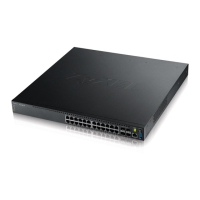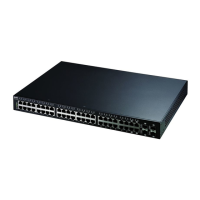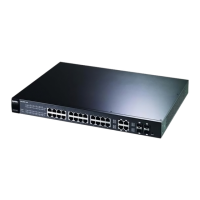Chapter 4 The Web Configurator
GS3700/XGS3700 Series User’s Guide
40
The following table describes the links in the navigation panel.
Table 5 Navigation Panel Links
LINK DESCRIPTION
Basic Settings
System I nfo This link takes you to a screen that displays general system and hardware monitoring
information.
General Setup This link takes you to a screen where you can configure general identification information
and time settings for the Switch.
Switch Setup This link takes you to a screen where you can set up global Switch parameters such as
VLAN type, MAC address learning, GARP and priority queues.
IP Setup This link takes you to a screen where you can configure the IP address, subnet mask
(necessary for Switch management) and set up to 128 IP routing domains.
Port Setup This link takes you to screens where you can configure speed, flow control and priority
settings for individual Switch ports.
PoE Setup For PoE model(s).
This link takes you to a screen where you can set priorities, PoE power-up settings and
schedule so that the Switch is able to reserve and allocate power to certain PDs.
Interface Setup This link takes you to a screen where you can create I Pv6 interfaces on the Switch.
IPv6 This link takes you to a screen where you can enable an IPv6 interface and configure the
IPv6 settings on the Switch.
Stacking This link takes you to a screen where you can view and configure stacking system for the
Switch.
DNS This link takes you to a screen where you can configure DNS (domain name server) IP
addresses.
Advanced Application
VLAN This link takes you to screens where you can configure port-based or 802.1Q VLAN
(depending on what you configured in the Switch Setup menu). You can also configure a
protocol based VLAN or a subnet based VLAN in these screens.
Static MAC
Forwarding
This link takes you to screens where you can configure static MAC addresses for a port.
These static MAC addresses do not age out.
Static Multicast
Forwarding
This link takes you to a screen where you can configure static multicast MAC addresses
for port(s). These static multicast MAC addresses do not age out.
Filtering This link takes you to a screen to set up filtering rules.
Spanning Tree
Protocol
This link takes you to screens where you can configure the RSTP/ MRSTP/ MSTP to prevent
network loops.
Bandwidth Control This link takes you to screens where you can cap the maximum bandwidth allowed on a
port.
Broadcast Storm
Control
This link takes you to a screen to set up broadcast filters.
Mirroring This link takes you to screens where you can copy traffic from one port or ports to
another port in order that you can examine the traffic from the first port without
interference.
Link Aggregation This link takes you to screen where you can logically aggregate physical links to form one
logical, higher-bandwidth link.
Port
Authentication
This link takes you to a screen where you can configure IEEE 802.1x port authentication
as well as MAC authentication for clients communicating via the Switch.
Port Security This link takes you to a screen where you can activate MAC address learning and set the
maximum number of MAC addresses to learn on a port.
Time Range This link takes you to a screen where you can configure time range for time-oriented
features like Classifier.

